Chapter: Electronic Circuits : Oscillators
Basic LC Oscillator Tank Circuit
Basic LC Oscillator Tank Circuit
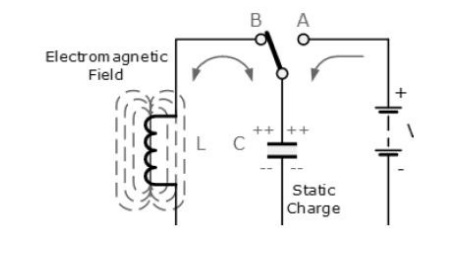
The circuit consists of an inductive coil, L
and a capacitor, C. The capacitor stores energy in the form of an electrostatic
field and which produces a potential (static voltage) across its plates, while
the inductive coil stores its energy in the form of an electromagnetic field.
The capacitor is charged up to the DC supply
voltage, V by putting the switch in position A. When the capacitor is fully
charged the switch changes to position B. The charged capacitor is now
connected in parallel across the inductive coil so the capacitor begins to
discharge itself through the coil.
The voltage across C starts falling as the
current through the coil begins to rise. This rising current sets up an
electromagnetic field around the coil which resists this flow of current. When
the capacitor, C is completely discharged the energy that was originally stored
in the capacitor, C as an electrostatic filed is now stored in the inductive
coil, L as an electromagnetic field around the coils windings.
As there is now no external voltage in the
circuit to maintain the current within the coil, it starts to fall as the
electromagnetic field begins to collapse. A back emf is induced in the coil (e=
-Ldi/dt) keeping the current flowing in the original direction. This current
now charges up the capacitor, c with the opposite polarity to its original
charge.
C continues to chare up until the current
reduces to zero and the electromagnetic field of the coil has collapsed
completely. The energy originally introduced into the circuit through the
switch, has been returned to the capacitor which again has an electrostatic
voltage potential across it, although it is now of the opposite polarity. The
capacitor now starts to discharge again back through the coil and the whole
process os repeated. The polarity of the voltage changes as the energy is
passed back and forth between the capacitor and inductor producing an AC type
sinusoidal voltage and current waveform.
This then forms the basis of an LC oscillators
tank circuit and theoretically this cycling back and forth will continue
indefinitely. However, every time energy is transferred from C to L or from L
to C losses occur which decay the oscillations.
This oscillatory action of passing energy back
and forth between the capacitor, C to the inductor, L would continue indefinitely
if it was not for energy losses within the circuit. Electrical energy is lost
in the DC or real resistance of the inductors coil, in the dielectric of the
capacitor, and in radiation from the circuit so the oscillation steadily
decreases until they die away completely and the process stops.
Then in a practical LC circuit the amplitude of the oscillatory
voltage decreases at each half cycle of oscillation and will eventually die
away to zero. The oscillations are then said to be "damped" with the
amount of damping being determined by the quality or Q-factor of the circuit.
1. Damped Oscillations
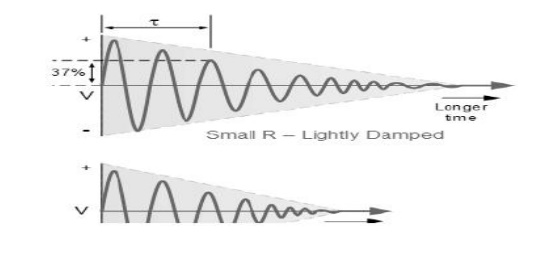
The frequency of the oscillatory voltage
depends upon the value of the inductance and capacitance in the LC tank
circuit. We now know that for resonance to occur in the tank circuit, there
must be a frequency point were the value of XC, the capacitive
reactance is the same as the value of XL, the inductive reactance (XL
= XC) and which will therefore cancel out each other out leaving
only the DC resistance in the circuit to oppose the flow of current.
If we now place the curve for inductive
reactance on top of the curve for capacitive reactance so that both curves are
on the same axes, the point of intersection will give us the resonance frequency
point, ( ƒr or ωr ) as shown below.
2. Resonance Frequency
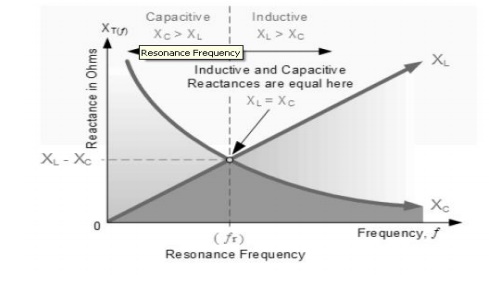
where: ƒr is in Hertz, L is in
Henries and C is in Farads.
Then the frequency at which this will happen is given as:
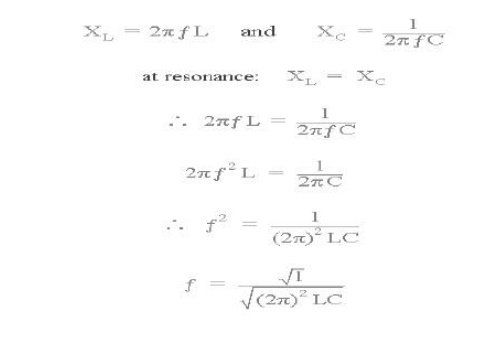
Then by simplifying the above equation we get
the final equation for Resonant
Frequency, ƒr
in a tuned LC circuit as:
3.
Resonant Frequency of a LC Oscillator
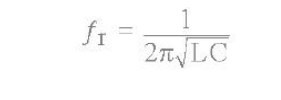
Where:
L is the Inductance in Henries
C is the Capacitance in Farads
ƒr is the Output Frequency in Hertz
This equation shows that if either L or C are
decreased, the frequency increases. This output frequency is commonly given the
abbreviation of ( ƒr ) to identify it as the "resonant frequency". To
keep
the oscillations going in an LC tank circuit, we
have to replace all the energy lost in each oscillation and also maintain the
amplitude of these oscillations at a constant level.
The amount of energy replaced must therefore be
equal to the energy lost during each cycle. If the energy replaced is too large
the amplitude would increase until clipping of the supply rails occurs.
Alternatively, if the amount of energy replaced is too small the amplitude
would eventually decrease to zero over time and the oscillations would stop.
The simplest way of replacing this lost energy
is to take part of the output from the LC tank circuit, amplify it and then
feed it back into the LC circuit again. This process can be achieved using a
voltage amplifier using an op-amp, FET or bipolar transistor as its active device.
However, if the loop gain of the feedback
amplifier is too small, the desired oscillation decays to zero and if it is too
large, the waveform becomes distorted. To produce a constant oscillation, the
level of the energy fed back to the LC network must be accurately controlled.
Then there must be some form of automatic
amplitude or gain control when the amplitude tries to vary from a reference
voltage either up or down. To maintain a stable oscillation the overall gain of
the circuit must be equal to one or unity. Any less and the oscillations will
not start or die away to zero, any more the oscillations will occur but the
amplitude will become clipped by the supply rails causing distortion. Consider
the circuit below.
Related Topics